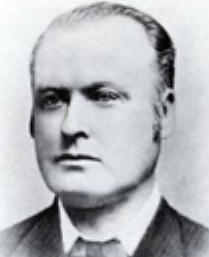Duncan Gillies
Duncan Gillies | |
|---|---|
 | |
| 14th Premier of Victoria | |
| In office 18 February 1886 – 5 November 1890 | |
| Preceded by | James Service |
| Succeeded by | James Munro |
| Personal details | |
| Born | 14 January 1834[1] Lanark, Glasgow, Scotland |
| Died | 12 September 1903 (aged 69)[1] Carlton, Melbourne, Victoria |
| Nationality | Australian |
| Spouse | Harriett Turquand Fillan |
Duncan Gillies (14 January 1834 – 12 September 1903), was an Australian colonial politician who served as the 14th Premier of Victoria.[1]
Gillies was born at Overnewton near Glasgow, Scotland, where his father had a market garden. He was sent to the high school until he was about 14, when he entered an office in Glasgow. In 1852, he arrived in Melbourne and travelled to the goldfields at Ballarat, where he worked first as a miner and later as a businessman and company director.
Gillies was elected to the Victorian Legislative Assembly for Ballarat West in 1861, holding that seat until 1868. A conservative, he was President of the Board of Lands and Works in the short-lived government of Charles Sladen in 1868, which cost him his seat at Ballarat, a strongly liberal constituency. He was elected for Maryborough 1870–77, Rodney 1877–89, Eastern Suburbs 1889–94 and Toorak 1897–1903. He was Commissioner for Railways and Roads in the ministries of James Francis and George Kerferd from 1872 to 1875, and Agriculture Minister in the third government of Sir James McCulloch in 1875–77.
In both the first (1880) and second (1883–86) governments of Service, Gillies was Commissioner for Railways and Vice-President of the Board of Land and Works. He was also Minister for Public Instruction 1884–86. As Railways Minister, he proved to be amenable to lobbying from members of parliament and others, initiating the 1884 Railway Construction Act (nicknamed the Octopus Act) which extravagantly authorised the building of 59 new rail lines.[2] He also assisted the passage of a bill to allow the Melbourne Tramway and Omnibus Company monopoly rights to operate a cable tram network in the city and suburbs.[3]
Service retired before the 1886 elections and Gillies succeeded him as Premier, forming a coalition government with the liberal leader Alfred Deakin, and winning a comfortable majority over a divided opposition at the elections. The Gillies ministry presided over the climax of the long economic boom which Victoria had enjoyed since the gold rushes of the 1850s. The great Victorian Land Boom took off in late 1880s and reached a climax in 1890. There was no regulation of the banking and finance industries at that time, and no expectation that governments could or should protect investors against unsound or unscrupulous financial schemes. More than 50 million pounds of speculative capital from Britain flowed into the colony, much of which was spent buying land in suburban Melbourne at hugely inflated prices. Gillies was not himself responsible for that, although his government did nothing to prevent it.
The Gillies government was easily re-elected in 1889, but the Boom collapsed after 1890 and a sharp recession followed. In October, Gillies was defeated in a confidence motion when a section of his own followers led by James Munro turned against him. In 1891, the recession turned into a depression, and Gillies was among the many speculators and shareholders who were wiped out in the crash.
In 1893, Gillies withdrew from active politics, reluctantly accepting the post of agent-general in London. On his return to Victoria, he successfully contested the seat of Toorak in 1897. In 1902, he was elected Speaker, a post he held until his death the following year. He had always been considered to be a bachelor but, after his death, it was disclosed that, in 1897, he had married Harriett Turquand Fillan (née Theobald), a widow of 37, while in London. She had been persuaded by Gillies' friends to return to her nursing in Johannesburg without announcing herself to Melbourne society.[3] He had declined the offer of a K.C.M.G. in 1887.
A portrait of Gillies by Josephine Muntz-Adams hangs in Parliament House Victoria.[4]
References
- ^ a b c Serle, Percival (1949). "Gillies, Duncan". Dictionary of Australian Biography. Sydney: Angus & Robertson.
- ^ Venn, Michael. "Speight, Richard (1838–1901)". Australian Dictionary of Biography. Australian National University. Retrieved 13 August 2019.
- ^ a b Beever, Margot. "Gillies, Duncan (1834–1903)". Australian Dictionary of Biography. Australian National University. Retrieved 13 August 2019.
- ^ Gallagher, Robin. "Parliament of Victoria - Duncan Gillies portrait". Parliament.vic.gov.au. Retrieved 13 January 2018.
Bibliography
- Geoff Browne, A Biographical Register of the Victorian Parliament, 1900-84, Government Printer, Melbourne, 1985
- Don Garden, Victoria: A History, Thomas Nelson, Melbourne, 1984
- Kathleen Thompson and Geoffrey Serle, A Biographical Register of the Victorian Parliament, 1856-1900, Australian National University Press, Canberra, 1972
- Raymond Wright, A People's Counsel. A History of the Parliament of Victoria, 1856-1990, Oxford University Press, Melbourne, 1992
- Serle, Percival (1949). "Gillies, Duncan". Dictionary of Australian Biography. Sydney: Angus & Robertson.
- Margot Beever, 'Gillies, Duncan (1834 - 1903)', Australian Dictionary of Biography, Volume 4, MUP, 1972, pp. 250–252.
